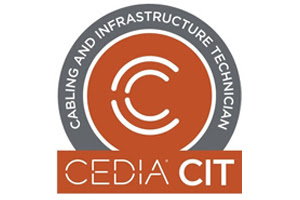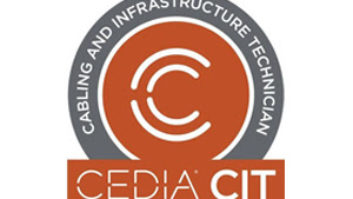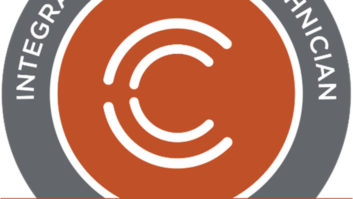
In January, CEDIA shared the news that the Cabling and Infrastructure Technician (CIT) exam had earned accreditation to the ISO/IEC 17024:2012, General Requirements for Bodies Operating Certification of Persons. This is an honor for CEDIA — we’ve now been recognized by ANSI’s Accreditation Board as the providers of a valid, fair, and reliable personnel assessment, created and maintained in accordance with the most widely respected global standards. It also honors the work of the many volunteers who generously gave their time and expertise to create the structure of the certification program, the exam content outline, and the exam questions according to ISO requirements. More important than what this accreditation says about CEDIA or even our volunteers, though, is what it will do for the industry, for integration firms, and for individual CIT-holders.
The CIT is a foundational exam. It assesses technicians whose primary task is to perform basic infrastructure wiring for low-voltage technology systems in a residential or commercial setting. That means this exam applies to people working not just in the custom integration field, but in any low-voltage trade, including commercial AV security, HVAC, etc. CEDIA’s certification staff and volunteers designed the CIT this way in recognition of a couple of basic realities. First, our members cannot be pigeonholed into solely residential applications — many integration firms offer a variety of services, including residential, light commercial, MDU, security, and more. Second, at this very foundational level — infrastructure installation — there is an enormous amount of overlap among low-voltage trades.

Moving our Seat to the Head of the Table
Having an ISO/IEC 17024 accredited exam that applies to multiple allied trades maintained by their industry association benefits the home technology industry in two ways. First, it elevates the profile of the industry as an authority within its domain. The home technology association is where members of any low-voltage trade can come to get a globally recognized certification in cabling and infrastructure; therefore, the home technology industry are the experts on the matter.
Second, it gives all members of a project team a common understanding of foundational concepts around cabling and infrastructure. When integrators sit down with security contractors, builders, HVAC pros, and plumbers, they can all share a common understanding of vocabulary, concepts, and best practices based on the CIT Exam content outline.
Growing Businesses and Careers

The foundational nature of the CIT is also intended to help integrators grow their teams and individuals advance their careers. The exam is designed to test whether candidates can use proper tools and techniques; follow instructions per project documentation; operate in a safe and professional manner on the jobsite; and understand the basic function of the wiring and termination components being installed. A CIT-certified individual should be able to work billable hours on a jobsite under supervision and is ready to advance to new skills and responsibilities. It’s not the terminus of a career path; it’s a gateway.
The CIT offers employers a standard, vendor-neutral benchmark that can be recognized across businesses. Any CIT they hire has a specific, independently verified set of knowledge and skills. Employers can also use the exam as a benchmark for their own staff. It gives them an objective measure of their readiness to bill hours, advance in their careers, or cross-train colleagues.
The CIT certification belongs to the individual who earns it, not the company — and it stays with them for as long as they maintain it through continuing education. That means the CIT is an asset to them throughout their careers. When applying for a job — or bidding on projects — it’s a differentiator that adds objective weight to any claim of competence. It’s one thing to have a skill on your resume — it’s another to have proof.
Advancing Toward Mastery
Of course, for many, the CIT will only be the beginning. What’s next? CEDIA’s long-term goal is to create a set of stackable certifications that integrators can use to indicate their expertise and specialized knowledge. Our new Integrated Systems Technician (IST) certification is the next step in this path. This certification applies to technicians who can work independently to perform all functions related to the pre-wire (First Fix) and trim-out (Second Fix) phases of a project, including troubleshooting common errors and verifying system functionality.
Any potential IST must first prove they have got the skills and knowledge of a CIT; CIT certification is a prerequisite to taking the IST exam. Like the CIT, the IST was built from the ground up to conform to ISO/IEC 17024. We’ll be submitting it for accreditation in the Spring of 2022.
The connected home marketplace is extremely attractive, and it’s only going to get more crowded. Globally recognized certification is a superb way to demonstrate pride in the industry’s professionalism. It’s a declaration of who we are: a vetted, trustworthy industry with highly specialized expertise.
If you’re ready to begin your certification journey, or to build a certification benchmarking program for your staff, CEDIA has many resources to help. Visit cedia.net/certification to learn more.
David Whitney is senior director of certification for CEDIA.







